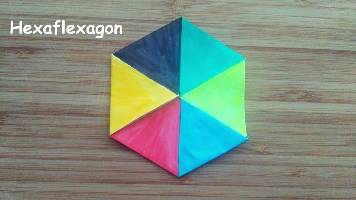Summary
In this lesson, students will create and explore mathematics found in hexaflexagons. This includes learning more about translations, rotations, and reflections of polygons, showing how these types of transformations preserve congruency, and learning to calculate area of trapezoids and composite figures.
Essential Question(s)
How do symmetries found in hexagons translate to other shapes and transformations?
Snapshot
Engage
Students create a tri-hexaflexagon.
Explore
Students explore various facets of their tri-hexaflexagon.
Explain
Students explain the types of symmetry found in their tri-hexaflexagon and shapes that form the tri-hexaflexagon.
Extend
Students create and explore a hexahexaflexagon.
Evaluate
Students reflect on their learning.
Materials
Plain copy paper
Markers
Pens
Hexaflexagon and Hexahexaflexagon templates (attached)
Exploring Your Tri-Hexaflexagon handout (attached)
\What So What Now What handout (attached)
Tape or glue
Scissors
A flat work surface
Engage
Students make a hexaflexagon.
As students are learning to construct a hexaflexagon, the way in which you guide them can be more or less hands-on. The two methods described below are extremes, and you can use your own discretion to provide as little or as much guidance and scaffolding as your students need.
More Hands-OFF Method: Distribute a sheet of paper to each student. Allow students to cut out an even strip of paper to their satisfaction. Keep in mind that some will work and some won't. (Again, this is an exploratory method that is more hands-off.) Have students determine how they can divide the strip of paper into 10 equilateral triangles (triangles that have three equal sides and three equal angles). Ask students to fold them up to create their hexaflexagons. This method might require more time, comfort with students feeling frustrated, and a flexible (pun intended) level of guidance when students are struggling. Help students as they need it, but first try asking questions to help guide students. For example, if a student's hexaflexagon isn't working, ask, "Have you considered folding in a different way?"
More Hands-ON Method: Allow students access to the attached hexaflexagon template. Play the videos provided on Vi Hart's website to help show students how to construct their hexaflexagons. Show struggling students how to fold to get a good crease. Show students how to fold the hexaflexagon so that it flexes. There is obviously more showing here, but students are still doing. You might want to have students try one on their own after your initial guidance.
The goal with either method is for students to do the constructing. The way you go about working with your students, though, is entirely up to you!
Explore
Arrange students in groups of three and assign each a role: Recorder, Sharer, or Questioner.
Recorders will document the group's answers.
Sharers will explain the group's answers to the whole class.
Questioners will read questions to the group and pose new questions.
Tell students that they will be exploring the hexaflexagons that they constructed to uncover the hidden side.
Working in their groups of three, ask students to assume their assigned roles and work through the questions in the Exploring your Tri-Hexaflexagon handout. All students are expected to participate and describe what shapes they see within the hexaflexagon. Remind students that the questioners read the questions, recorders record the answers, and sharers share out to the whole class.
Explain
Ask each group's sharer come to the front of the room to share their answers with the whole class.
After each group presents, open the floor for discussion as a whole class.
Extend
This section is similar to the Explore, but this time there is less analysis of the hexaflexagon and more construction.
Ask students to construct a hexa-hexaflexagon. To do this, provide students with the hexa-hexaflexagon handout, along with scissors and tape or glue. Give them the option to color their construction.
Evaluate
Pass out copies of the What? So What? Now What? handout and have students respond to the following prompts:
What? What did you do in today's activity?
So what? What did you learn in today's activity and how does it connect to mathematics?
Now what? What will you take with you from this lesson? (This obviously could be the hexaflexagon itself, but you're looking for a more conceptual takeaway.)
Resources
Hart, V. (n.d.). Hexaflexagons. Retrieved from http://vihart.com/hexaflexagons/
Gathering4Gardener (2017). Hexahexaflexagon Blank Template. Retrieved from http://www.puzzles.com/hexaflexagon/img/hexahexaflexagon_blank_template.pdf
K20 Center. (n.d.). Think-Pair-Share. Strategies. https://learn.k20center.ou.edu/strategy/d9908066f654727934df7bf4f5064b49
K20 Center. (n.d.). What? So What? Now What?. Strategies. https://learn.k20center.ou.edu/strategy/b30762a7557ba0b391f207f4c6002113


